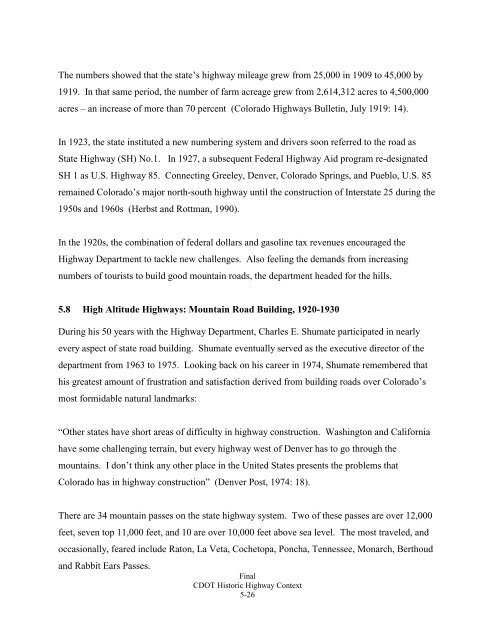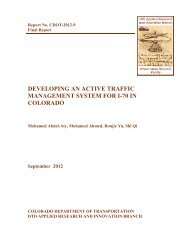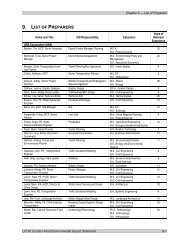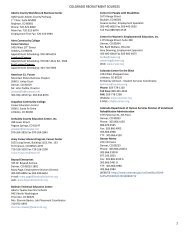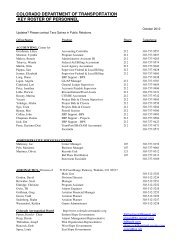Chapter 5 THE AUTOMOBILE AGE BEGINS, 1890-1930 - Colorado ...
Chapter 5 THE AUTOMOBILE AGE BEGINS, 1890-1930 - Colorado ...
Chapter 5 THE AUTOMOBILE AGE BEGINS, 1890-1930 - Colorado ...
Create successful ePaper yourself
Turn your PDF publications into a flip-book with our unique Google optimized e-Paper software.
The numbers showed that the state’s highway mileage grew from 25,000 in 1909 to 45,000 by<br />
1919. In that same period, the number of farm acreage grew from 2,614,312 acres to 4,500,000<br />
acres – an increase of more than 70 percent (<strong>Colorado</strong> Highways Bulletin, July 1919: 14).<br />
In 1923, the state instituted a new numbering system and drivers soon referred to the road as<br />
State Highway (SH) No.1. In 1927, a subsequent Federal Highway Aid program re-designated<br />
SH 1 as U.S. Highway 85. Connecting Greeley, Denver, <strong>Colorado</strong> Springs, and Pueblo, U.S. 85<br />
remained <strong>Colorado</strong>’s major north-south highway until the construction of Interstate 25 during the<br />
1950s and 1960s (Herbst and Rottman, 1990).<br />
In the 1920s, the combination of federal dollars and gasoline tax revenues encouraged the<br />
Highway Department to tackle new challenges. Also feeling the demands from increasing<br />
numbers of tourists to build good mountain roads, the department headed for the hills.<br />
5.8 High Altitude Highways: Mountain Road Building, 1920-<strong>1930</strong><br />
During his 50 years with the Highway Department, Charles E. Shumate participated in nearly<br />
every aspect of state road building. Shumate eventually served as the executive director of the<br />
department from 1963 to 1975. Looking back on his career in 1974, Shumate remembered that<br />
his greatest amount of frustration and satisfaction derived from building roads over <strong>Colorado</strong>’s<br />
most formidable natural landmarks:<br />
“Other states have short areas of difficulty in highway construction. Washington and California<br />
have some challenging terrain, but every highway west of Denver has to go through the<br />
mountains. I don’t think any other place in the United States presents the problems that<br />
<strong>Colorado</strong> has in highway construction” (Denver Post, 1974: 18).<br />
There are 34 mountain passes on the state highway system. Two of these passes are over 12,000<br />
feet, seven top 11,000 feet, and 10 are over 10,000 feet above sea level. The most traveled, and<br />
occasionally, feared include Raton, La Veta, Cochetopa, Poncha, Tennessee, Monarch, Berthoud<br />
and Rabbit Ears Passes.<br />
Final<br />
CDOT Historic Highway Context<br />
5-26


